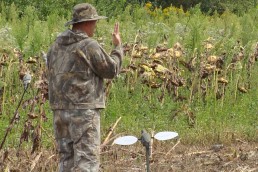Tactics for Dove Hunting Success
SHARE THIS POST
Planning ahead and employing some of Tom Berg’s tactics can help to improve your dove hunting success this season.
Picking your shots when doves fly over the field you are hunting is very important, even on opening day. Doves are surprisingly smart, and it doesn’t take long for them to avoid areas where there is a lot of gunfire. So don’t start blasting away at every dove you see. Wait for birds to fly in close enough for a good shot and let birds on the edge of your gun’s range keep flying. Holding your fire for a good shot is a time-honored tactic.
There are plenty of other ways to increase your odds of success in the dove fields, too. One of the best and easiest tactics is to conceal your presence. As I said, doves are smart. If they see people standing in the field where they were planning to feed, they will simply veer off and stop somewhere else. So, wear camouflage clothing to hide yourself from the prying eyes of the birds. A camo shirt with matching camo pants is preferred, although khaki-colored pants will also work. Your favorite camo hat can finish your hunting outfit.
While camouflage clothing is a definite plus, it is also a good idea to disappear into the local surroundings if possible. Try positioning on the edge of the bushes or weeds bordering the dove field to hide your body from the eyes of birds flying overhead. If the bushes or weeds are only waist-high, it is a good idea to move your seat right into the vegetation and sit while you wait for the next group of doves to fly over. Keep a low profile and remain hidden from view.
Bring a chair or 5-gallon bucket to sit on when the action slows. There are mobile hunting chairs (with wheels) available that make getting your gear to and from the field a lot easier. These chairs also feature storage bins for holding ammo, drinks, additional gear and harvested doves. Just make sure your bucket or chair is green or camo colored. A bright orange bucket defeats the purpose of your camo clothing!
Another easy way to increase your odds is to use plastic bird decoys to help attract doves. These can be very effective, especially if the decoys are painted to look exactly like real mourning doves. Both plain stationary decoys and those with moveable wings work. Since doves often feed in small groups, set up your decoys in pairs or with three or four decoys together. Try to position them on the bare branches of trees or bushes, or on fences so they can be easily seen from above. Doves flying overhead will often come in for a closer look if they think other birds have found a food source.
Are you enjoying this post?
You can be among the first to get the latest info on where to go, what to use and how to use it!
Hitting a dove after a good shot is only half the battle. Depending on how weed-free the field, it can be difficult to find the bird once it falls from the sky. Although it is usually easy to find doves that fall into a well-maintained field of sunflowers with bare dirt and no weeds between the rows, it is an altogether different matter if the dove falls into tall grass or weeds.
As soon as you hit a bird, keep your eye on it all the way to the ground. Then keep your eye on it until your hunting partners stop shooting and you can walk out and get it. Make a beeline straight for the spot where it landed and don’t look away. If you do have to look away, be sure to identify a landmark where it fell, like an extra-tall weed or a funny-looking bush. It’s amazing how easy a small dove can disappear when it hits the ground if you are not paying attention. It is your responsibility as an ethical hunter to make every effort to retrieve each bird you shoot, so be sure to keep your eye on it and find it.
Of course, a well-maintained shotgun is your most essential piece of equipment. Some hunters prefer a 20-gauge gun while others choose their trusty 12-gauge shotgun. It is helpful to get in a little practice with clay pigeons before the season starts to hone your shooting skills. Many hunters also install an improved cylinder or modified choke in the barrel of their guns to maximize their effectiveness. Early in the season, many shots are within 35 yards.
Although there is nothing hunters can do about the weather, it’s helpful to know what type of weather is. Hot and dry weather conditions with calm winds are conducive to a good dove hunt. Doves usually stay put during stable weather. Early September storms and cold fronts are bad news for dove hunters, because they encourage the birds to migrate and leave the area. The best hunting is often in the early morning and the late afternoon, so be sure to plan your hunts accordingly.
Get better results from the time you spend hunting. Use information from the pros found in every issue of MidWest Outdoors, available by subscribing on our website.
MWO
SHARE THIS POST
You may also like...
Nothing found.
Did you enjoy this post?
You can be among the first to get the latest info on where to go, what to use and how to use it!
Tom Berg
A lifelong outdoorsman and award-winning outdoor writer and nature photographer, Tom Berg has been the Executive Director/Treasurer of the Hoosier Outdoor Writers group for the past 14 years. When he is not writing, he would rather be outside fishing, hunting or trapping than doing just about anything else.
